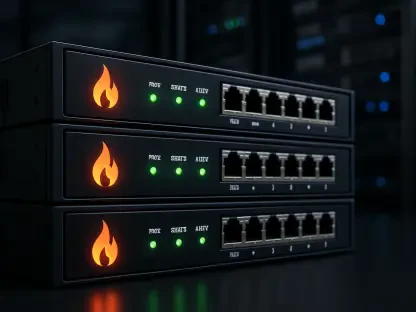The surge in artificial intelligence (AI) applications is reshaping the landscape of network infrastructure and security. As AI continues to evolve, it brings both opportunities and challenges, prompting numerous changes in the way networks are designed, managed, and secured. The integration of AI demands higher levels of real-time data processing and significantly lower latency, pushing traditional network architectures to their limits and necessitating substantial investment in new technologies. The implications extend to data traffic management and the evolution of network security, highlighting the need for collaborative efforts to optimize networks for AI workloads.
Increased Complexity in Network Infrastructure
The integration of AI applications into network infrastructure has significantly heightened its complexity. As organizations deploy large-scale AI models, they must invest in sophisticated hardware like AI factories and massive GPU clusters to manage the substantial computational demands. These investments are essential for addressing the increasing complexity, but they also introduce new challenges in terms of connectivity and latency. For instance, AI factories, which are essentially massive clusters of GPUs, require a network infrastructure capable of supporting immense data throughput and real-time processing. This shift necessitates the adoption of advanced networking technologies and architectures to meet the stringent performance requirements.
Moreover, cloud-based solutions and small language models (SLMs) are gaining traction due to their scalable and efficient ways to handle AI workloads. These methods mitigate data gravity issues, where data is bound to its location, posing challenges for distributed AI processing. SLMs, in particular, offer a more lightweight and versatile approach to AI, allowing for easier deployment across various cloud environments. These developments illustrate a critical shift in how network infrastructure must adapt to meet the demands of AI. As organizations continue to invest in these advanced solutions, the traditional network architecture is being redefined to support the new operational realities imposed by AI.
AI-Related Network Traffic Management
AI-generated network traffic is poised to dominate overall network activity, demanding robust traffic management strategies to ensure seamless data flow and efficient network operations. With the anticipated surge in AI traffic, traditional network services need significant augmentation and optimization to handle the increased load. One of the critical components in this transformation is the use of application programming interfaces (APIs). APIs act as the connective tissue for AI-powered applications, enabling integration and communication across various systems. This integration necessitates a comprehensive approach to traffic management and steering capabilities, ensuring that networks can handle the complexities of AI-generated data.
As AI applications process multimodal data in real-time, networks must adapt to handle unpredictable GPU availability and ensure efficient data access. Innovations in load balancing, traffic management, and data processing are key to managing the influx of AI-generated traffic effectively. For example, advanced load balancing techniques can distribute the computational load across multiple resources, preventing bottlenecks and ensuring smooth operation. Similarly, enhanced traffic management strategies can prioritize critical data flows, optimizing network performance even under heavy AI workloads. These innovations are crucial to maintaining the efficiency and reliability of networks in an AI-driven future.
Enhancing Network Security with AI
While AI offers immense potential to bolster network security, it simultaneously introduces sophisticated cyber threats, creating a dual-edged sword for network administrators. AI-driven security models are becoming essential for identifying and countering emerging threats. By leveraging machine learning algorithms, these models can detect anomalies and patterns indicative of cyberattacks, thereby enhancing overall network security. For instance, machine learning techniques can identify previously unknown threats by analyzing vast amounts of data and recognizing patterns that would be impossible for humans to detect. This capability is particularly valuable in a landscape where cyber threats are continually evolving.
F5 is leading the charge in AI-driven security investments, developing comprehensive models through its AI Center of Excellence. These efforts aim to create an AI data fabric that supports policy creation and delivers insightful threat intelligence. By continuously refining their algorithms and incorporating new data, these AI-driven models can adapt to the changing threat landscape in real-time. This proactive approach to security not only mitigates the risk of cyberattacks but also provides organizations with the tools they need to respond swiftly and effectively when threats arise. As AI continues to evolve, its role in network security is likely to become even more integral, necessitating ongoing investment and innovation in AI-driven security measures.
Collaboration and Partnerships
Building AI-optimized networks is not a solitary endeavor. It requires collaboration among various stakeholders, including technology companies, hyperscalers, and telecommunications providers. F5 emphasizes the importance of partnerships in computing, networking, and storage to create robust and future-proof AI ecosystems. These collaborative efforts are crucial for addressing the complex challenges and leveraging the substantial opportunities presented by AI in networking. By bringing together expertise from different domains, these partnerships facilitate the integration of AI technologies into network infrastructures, fostering innovation and ensuring that networks can handle the demands of AI-driven applications.
For instance, partnerships between tech companies and hyperscalers can lead to the development of new solutions that enhance the performance and efficiency of AI workloads. Similarly, collaboration with telecommunications providers can help address connectivity challenges, ensuring that networks have the necessary bandwidth and reliability to support AI applications. By working together, these stakeholders can develop comprehensive solutions that keep pace with technological advancements and ensure that networks remain capable of supporting the increasing demands of AI. This collaborative approach is essential for building the resilient and scalable network infrastructures needed for the future.
Overarching Trends in AI-Enhanced Networking
The rapid growth of artificial intelligence (AI) applications is significantly transforming network infrastructure and security. As AI progresses, it introduces both opportunities and challenges that drive changes in how networks are designed, managed, and protected. Integrating AI into these systems requires higher levels of real-time data processing and much lower latency, pushing existing network architectures to their limits. This creates an urgent need for substantial investments in cutting-edge technologies to keep up with AI’s demands.
The impact extends to data traffic management and the overall evolution of network security. Handling the influx of data generated by AI applications efficiently is essential, necessitating advanced strategies and tools to optimize performance. Furthermore, as AI becomes more embedded in various sectors, securing these networks becomes increasingly complex. Traditional security measures may no longer suffice, highlighting the necessity for innovative solutions to safeguard data and systems.
Collaboration among industry leaders, technology developers, and cybersecurity experts is vital to effectively address these issues. By working together, they can create robust, AI-optimized networks that offer both enhanced performance and security. This collaborative approach is key to successfully integrating AI into network infrastructures, ensuring they can meet current and future demands while maintaining the highest security standards.









